Quantification and Simulation of the Ecosystem Service Value of Karst Region in Southwest China
Abstract
:1. Introduction
2. Materials and Methods
2.1. Study Area
2.2. Data Sources
2.3. Methods
2.3.1. Construction of Dynamic ESV Equivalent Tables
2.3.2. Estimation of ESV
2.3.3. Exploratory Spatial Data Analysis
2.3.4. ESV Prediction with the PLUS Model
3. Results
3.1. LUCC in YP from 1990 to 2020
3.2. Characteristics of ESV Changes in YP from 1990 to 2020
3.2.1. Spatial and Temporal Evolution of ESV in YP
3.2.2. Changes in Spatial Autocorrelation of ESV in YP
3.3. Prediction of ESV for YP
4. Discussion
4.1. Reliability and Applicability of Research
4.2. Effect of LUCC on ESV
4.3. Strategies to Improve ES
4.4. Future Research
5. Conclusions
Author Contributions
Funding
Data Availability Statement
Acknowledgments
Conflicts of Interest
References
- Costanza, R.; Arge, R.; Groot, R.; Farber, S.; Grasso, M.; Hannon, B.; Limburg, K.; Naeem, S.; Neill, R.V.O.; Paruelo, J.; et al. The value of the world’s ecosystem services and natural capital. Nature 1997, 387, 253–260. [Google Scholar] [CrossRef]
- Hasan, S.; Zhen, L.; Miah, M.; Ahamed, T.; Samie, A. Impact of land use change on ecosystem services, A review. Environ. Dev. 2020, 34, 100527. [Google Scholar] [CrossRef]
- Liu, Z.; Liu, Z.; Zhou, Y.; Huang, Q. Distinguishing the Impacts of Rapid Urbanization on Ecosystem Service Trade-Offs and Synergies, A Case Study of Shenzhen, China. Remote Sens. 2022, 14, 4604. [Google Scholar] [CrossRef]
- Mancini, M.S.; Galli, A.; Coscieme, L.; Niccolucci, V.; Lin, D.; Pulselli, F.M.; Bastianoni, S.; Marchettini, N. Exploring ecosystem services assessment through Ecological Footprint accounting. Ecosyst. Serv. 2018, 30, 228–235. [Google Scholar] [CrossRef]
- Bai, X.; Ran, C.; Chen, J.; Luo, G.; Chen, F.; Xiao, B.; Long, M.; Li, Z.; Zhang, X.; Shen, Q.; et al. Methods, progess and prospect for diagnosis of karst ecosystem health in China, An overview. Chin. Sci. Bull. 2023, 68, 2550–2568. [Google Scholar]
- Nie, X.; Wang, Q.; Wu, J.; Wang, H.; Chen, Z.; He, J. Effectively enhancing perceptions of cultural ecosystem services, A case study of a karst cultural ecosystem. J. Environ. Manag. 2022, 315, 115189. [Google Scholar] [CrossRef]
- Gao, J.; Zuo, L.; Liu, W. Environmental determinants impacting the spatial heterogeneity of karst ecosystem services in Southwest China. Land Degrad. Dev. 2020, 32, 1718–1731. [Google Scholar] [CrossRef]
- Hu, Z.; Wang, S.; Bai, X.; Luo, G.; Li, Q.; Wu, L.; Yang, Y.; Tian, S.; Li, C.; Deng, Y. Changes in ecosystem service values in karst areas of China. Agric. Ecosyst. Environ. 2022, 301, 107026. [Google Scholar] [CrossRef]
- Zhang, X.; Xie, B.; Zhou, K.; Li, J.; Yuan, C.; Xiao, J.; Xie, J. Mapping ecosystem service clusters and exploring their driving mechanisms in karst peak-cluster depression regions in China. Ecol. Indic. 2023, 158, 111524. [Google Scholar] [CrossRef]
- Viglizzo, E.F.; Frank, F.C. Land-use options for Del Plata Basin in South America, Tradeoffs analysis based on ecosystem service provision. Ecol. Econ. 2006, 57, 140–151. [Google Scholar] [CrossRef]
- Tong, C.; Feagin, R.A.; Lu, J.; Zhang, X.; Zhu, X.; Wei, W.; He, W. Ecosystem service values and restoration in the urban Sanyang wetland of Wenzhou, China. Ecol. Eng. 2007, 29, 249–258. [Google Scholar] [CrossRef]
- Wu, Y.; Jie, C.; Xu, B.; Peng, C.; Ying, G. Ecosystem service value assessment for constructed wetlands, A case study in Hangzhou, China. Ecol. Econ. 2008, 68, 116–125. [Google Scholar] [CrossRef]
- Jenkins, W.A.; Murray, B.C.; Kramer, R.A.; Faulkner, S.P. Valuing ecosystem services from wetlands restoration in the Mississippi Alluvial Valley. Ecol. Econ. 2010, 69, 1051–1061. [Google Scholar] [CrossRef]
- Estoque, R.C.; Myint, S.W.; Wang, C.; Ishtiaque, A.; Aung, T.T.; Emerton, L.; Ooba, M.; Hijioka, Y.; Mon, M.S.; Wang, Z.; et al. Assessing environmental impacts and change in Myanmar’s mangrove ecosystem service value due to deforestation (2000–2014). Glob. Chang. Biol. 2018, 24, 5391–5410. [Google Scholar] [CrossRef]
- Negash, E.; Getachew, T.; Birhane, E.; Gebrewahed, H. Ecosystem Service Value Distribution Along the Agroecological Gradient in North-Central Ethiopia. Earth Syst. Environ. 2020, 4, 107–116. [Google Scholar] [CrossRef]
- Brown, G.; Hausner, V. An empirical analysis of cultural ecosystem values in coastal landscapes. Ocean. Coast. Manag. 2017, 142, 49–60. [Google Scholar] [CrossRef]
- Brander, L.; Wagtendonk, A.; Hussain, S.; McVittie, A.; Verburg, P.; de Groot, R.; van der Ploeg, S. Ecosystem service values for mangroves in Southeast Asia, A meta-analysis and value transfer application. Ecosyst. Serv. 2012, 1, 62–69. [Google Scholar] [CrossRef]
- Costanza, R.; Groot, R.; Sutton, P.; Ploeg, S.; Anderson, S.J.; Kubiszewski, I.; Farber, S.; Turner, R.K. Changes in the global value of ecosystem services. Glob. Environ. Chang. 2014, 26, 152–158. [Google Scholar] [CrossRef]
- Sannigrahi, S.; Bhatt, S.; Rahmat, S.; Paul, S.K.; Sen, S. Estimating global ecosystem service values and its response to land surface dynamics during 1995–2015. J. Environ. Manag. 2018, 223, 115–131. [Google Scholar] [CrossRef]
- Cao, S.; Liu, Y.; Su, W.; Zheng, X.; Yu, Z. The net ecosystem services value in mainland China. Sci. China-Earth Sci. 2018, 61, 595–603. [Google Scholar] [CrossRef]
- Baniya, B.; Tang, Q.; Pokhrel, Y.; Xu, X. Vegetation dynamics and ecosystem service values changes at national and provincial scales in Nepal from 2000 to 2017. Environ. Dev. 2019, 32, 100464. [Google Scholar] [CrossRef]
- Kubiszewski, I.; Costanza, R.; Dorji, L.; Thoennes, P.; Tshering, K. An initial estimate of the value of ecosystem services in Bhutan. Ecosyst. Serv. 2013, 3, E11–E21. [Google Scholar] [CrossRef]
- Remme, R.; Edens, B.; Schroter, M. Monetary accounting of ecosystem services, A test case for Limburg province, the Netherlands. Ecol. Econ. 2015, 112, 116–128. [Google Scholar] [CrossRef]
- Immerzeel, B.; Vermaat, J.; Riise, G.; Juutinen, A.; Futter, M. Estimating societal benefits from Nordic catchments, An integrative approach using a final ecosystem services framework. PLoS ONE 2021, 16, e0252352. [Google Scholar] [CrossRef]
- Li, T.; Li, W.; Qian, Z. Variations in ecosystem service value in response to land use changes in Shenzhen. Ecol. Econ. 2010, 69, 1427–1435. [Google Scholar] [CrossRef]
- Nikodinoska, N.; Paletto, A.; Pastorella, F.; Granvik, M.; Franzese, P. Assessing, valuing and mapping ecosystem services at city level, The case of Uppsala (Sweden). Ecol. Model. 2018, 368, 411–424. [Google Scholar] [CrossRef]
- Zhang, H.; Yang, Q.; Zhang, Z.; Lu, D. Spatiotemporal Changes of Ecosystem Service Value Determined by National Land Space Pattern Change, A Case Study of Fengdu County in The Three Gorges Reservoir Area, China. Int. J. Environ. Res. Public Health 2021, 18, 5007. [Google Scholar] [CrossRef]
- Liu, Y.; Li, J.; Yang, Y. Evaluation of forest ecosystem services based on biomass in Shanxi Province. Acta Ecol. Sin. 2012, 32, 2699–2706. [Google Scholar]
- Stoeckl, N.; Condie, S.; Anthony, K. Assessing changes to ecosystem service values at large geographic scale, A case study for Australia’s Great Barrier Reef. Ecosyst. Serv. 2021, 51, 101352. [Google Scholar] [CrossRef]
- Xie, G.; Zhang, C.; Zhang, L.; Chen, W.; Li, S. Improvement of the Evaluation Method for Ecosystem Service Value Based on Per Unit Area. J. Nat. Resour. 2015, 30, 1243–1254. [Google Scholar]
- Xie, G.; Zhen, L.; Lu, C.; Xiao, Y.; Chen, C. Expert Knowledge Based Valuation Method of Ecosystem Services in China. J. Nat. Resour. 2008, 5, 911–919. [Google Scholar]
- Pan, H.; Zhang, Q.; Li, J.; Xu, J.; Huang, P. Spatial and temporal evolution of ecosystem service value based on dynamic equivalent in Yi-Han severely impoverished areas. Acta Ecol. Sin. 2020, 40, 8218–8229. [Google Scholar]
- Holland, R.; Eigenbrod, F.; Armsworth, P.; Anderson, B.; Thomas, C.; Gaston, K. The influence of temporal variation on relationships between ecosystem services. Biodivers. Conserv. 2011, 20, 3285–3294. [Google Scholar] [CrossRef]
- Xie, G.; Zhang, C.; Zheng, L.; Zhang, L. Dynamic changes in the value of China’s ecosystem services. Ecosyst Serv. 2017, 26, 146–154. [Google Scholar] [CrossRef]
- Wang, J.; Liu, F.; Bai, X.; Dai, W.; Li, Q. The spatial and temporal evolution and simulation forecast of ecosystem service values in southwest China. Acta Ecol. Sin. 2019, 39, 7057–7066. [Google Scholar]
- Zhang, X.; Liu, L.; Chen, X.; Gao, Y.; Mi, Y. GLC_FCS30, Global land-cover product with fine classification system at 30€m using time-series Landsat imagery. Earth Syst. Sci. Data 2021, 13, 2753–2776. [Google Scholar] [CrossRef]
- Chen, P. Monthly NPP dataset covering China’s terrestrial ecosystems at north of 18°N (1985–2015). J. Glob. Chang. Data Discov. 2019, 3, 34–41+143–150. [Google Scholar]
- Li, J.; He, H.; Zeng, Q.; Chen, L.; Sun, R. A Chinese soil conservation dataset preventing soil water erosion from 1992 to 2019. Sci. Data 2023, 10, 319. [Google Scholar] [CrossRef]
- Peng, S.; Ding, Y.; Liu, W.; Li, Z. 1 km monthly temperature and precipitation dataset for China from 1901 to 2017. Earth Syst. Sci. Data 2019, 11, 1931–1946. [Google Scholar] [CrossRef]
- Huo, X.; Li, H.; Sun, D.; Zhou, L.; Li, B. Combining Geostatistics with Moran’s I Analysis for Mapping Soil Heavy Metals in Beijing, China. Int. J. Environ. Res. Public Health 2012, 9, 995–1017. [Google Scholar] [CrossRef]
- Aghadadashi, V.; Molaei, S.; Mehdinia, A.; Mohammadi, J.; Moeinaddini, M.; Bakhtiari, A.R. Using GIS, geostatistics and Fuzzy logic to study spatial structure of sedimentary total PAHs and potential eco-risks; An Eastern Persian Gulf case study. Mar. Pollut. Bull. 2019, 49, 110489. [Google Scholar] [CrossRef]
- Catchpole, S.; Rivera, R.; Hernández, C.; De La Pena, J.; Conzalez, P. Predicting spatial distribution patterns and hotspots of fish assemblage in a coastal basin of the central-south of Chile, by geostatistical techniques. J. Limnol. 2019, 78, 220–232. [Google Scholar] [CrossRef]
- Liang, X.; Guan, Q.; Clarke, C.; Liu, S.; Wang, B.; Yao, Y. Understanding the drivers of sustainable land expansion using a patch-generating land use simulation (PLUS) model, A case study in Wuhan, China. Comput. Environ. Urban Syst. 2021, 85, 101569. [Google Scholar] [CrossRef]
- Wang, Q.; Wang, H.; Chang, R.; Zeng, H.; Bai, X. Dynamic simulation patterns and spatiotemporal analysis of land-use/land-cover changes in the Wuhan metropolitan area, China. Ecol. Model. 2022, 464, 109850. [Google Scholar] [CrossRef]
- Costanza, R.; Groot, R.; Braat, L.; Kubiszewski, I.; Fioramonti, L.; Sutton, P.; Farber, S.; Grasso, M. Twenty years of ecosystem services, How far have we come and how far do we still need to go? Ecosyst. Serv. 2017, 28, 1–16. [Google Scholar] [CrossRef]
- Mendoza-González, G.; Martínez, M.L.; Lithgow, D.; Pérez-Maqueo, O.; Simonin, P. Land use change and its effects on the value of ecosystem services along the coast of the Gulf of Mexico. Ecol. Econ. 2012, 82, 23–32. [Google Scholar] [CrossRef]
- Solomon, N.; Segnon, A.C.; Birhane, E. Ecosystem Service Values Changes in Response to Land-Use/Land-Cover Dynamics in Dry Afromontane Forest in Northern Ethiopia. Int. J. Environ. Res. Public Health 2019, 16, 4653. [Google Scholar] [CrossRef]
- Yi, H.; Gueneralp, B.; Filippi, A.M.; Kreuter, U.P.; Guneralp, I. Impacts of Land Change on Ecosystem Services in the San Antonio River Basin, Texas, from 1984 to 201. Ecol. Econ. 2017, 135, 125–135. [Google Scholar] [CrossRef]
- Sannigrahi, S.; Chakraborti, S.; Joshi, P.K.; Keesstra, S.; Sen, S.; Paul, S.K.; Kreuter, U.; Sutton, P.C.; Jha, S.; Dang, K.B. Ecosystem service value assessment of a natural reserve region for strengthening protection and conservation. J. Environ. Manag. 2019, 244, 208–227. [Google Scholar] [CrossRef]
- Zhang, H.; Liao, X.; Zhai, T. Evaluation of ecosystem service based on scenario simulation of land use in Yunnan Province. Phys. Chem. Earth 2018, 104, 58–65. [Google Scholar] [CrossRef]
- Wang, F.; Fu, W.; Chen, J. Spatial–Temporal Evolution of Ecosystem Service Value in Yunnan Based on Land Use. Land 2022, 11, 2217. [Google Scholar] [CrossRef]
- Luo, R.; Chen, X.; Zhang, L.; Yang, W. Spatial-temporal Evolution of Ecosystem Service Value of Counties in YP Based on Land Utilization. J. Anhui Agric. Sci. 2022, 50, 45–48+85. [Google Scholar]
- Wang, R.; Zhao, J.; Chen, G.; Lin, Y.; Yang, A.; Cheng, J. Coupling PLUS–InVEST Model for Ecosystem Service Research in Yunnan Province, China. Sustainability 2022, 15, 271. [Google Scholar] [CrossRef]
- Bryan, B.; Ye, Y.; Zhang, J.; Connor, J. Land-use change impacts on ecosystem services value, Incorporating the scarcity effects of supply and demand dynamics. Ecosyst. Serv. 2018, 32, 144–157. [Google Scholar] [CrossRef]
- Pérez-Ramírez, I.; Requena-Mullor, J.; Castro, A.; García-Llorente, M. Land transformation changes people’s values of ecosystem services in Las Vegas agrarian landscapes of Madrid Spain. Land Use Policy 2023, 134, 106921. [Google Scholar] [CrossRef]
- Sun, C.; Ma, Y.; Gong, L. Response of ecosystem service value to land use/cover change in the northern slope economic belt of the Tianshan Mountains, Xinjiang, Chin. J. Arid. Land 2021, 13, 1026–1040. [Google Scholar] [CrossRef]
- Zhang, J.; Li, X.; Zhang, C.; Yu, L.; Wang, J.; Wu, X.; Hu, Z.; Zhai, Z.; Li, Q.; Wu, G.; et al. Assessing spatiotemporal variations and predicting changes in ecosystem service values in the Guangdong-Hong Kong-Macao Greater Bay Area. Gisci. Remote Sens. 2022, 59, 184–199. [Google Scholar] [CrossRef]
- Xiao, W. Remote Sensing Monitoring of Cropland Change for the Recently 10 Years in Yunnan Based on GEE Platform; Yunnan Normal University: Kunming, China, 2020. [Google Scholar] [CrossRef]
- Xing, L.; Zhu, Y.; Wang, J. Spatial spillover effects of urbanization on ecosystem services value in Chinese cities. Ecol. Indic. 2021, 121, 107028. [Google Scholar] [CrossRef]
- Wang, Y.; Ding, J.; Li, X.; Zhang, J.; Ma, G. Impact of LUCC on ecosystem services values in the Yili River Basin based on an intensity analysis model. Acta Ecol. Sin. 2022, 42, 3106–3118. [Google Scholar]
- Liu, M.; Jia, Y.; Zhao, J.; Shen, Y.; Pei, H.; Zhang, H.; Li, Y. Revegetation projects significantly improved ecosystem service values in the agro-pastoral ecotone of northern China in recent 20 years. Sci. Total Environ. 2021, 788, 147756. [Google Scholar] [CrossRef]
- Deng, Y. Research on Land Cover Classification in YP Based on MODIS Data; Yunnan Normal University: Kunming, China, 2015. [Google Scholar]
- Han, T.; Xi, X.; Wang, C.; Bao, Y.; Luo, S. Study on Forest Classification in Yunnan based on Decision Tree Algorithm. Remote Sens. Technol. Appl. 2014, 29, 744–751. [Google Scholar]
- Yang, Y.; Huang, G.; Wang, X.; Su, H.; Zhi, C. Research on Prediction of Forest Resources and the Carbon Sequestration Potential in Yunnan Pronvince. For. Resour. Manag. 2017, 4, 44–49. [Google Scholar] [CrossRef]
- Han, L.; Pan, Y.; Gao, Q.; Ma, J. Evaluation and Prediction of the Cultivated Land Ecological Security in YP Based on PSR and Unbiased GM (1, 1) Model. Ecol. Econ. 2019, 35, 148–154. [Google Scholar]
- Nong, L. Evaluation of Ecological Vulnerability Evaluation of Yunnan Province Based on SPR Model; Yunnan Normal University: Kunming, China, 2021. [Google Scholar]
- Deng, C.; Liu, J.; Li, Z.; Xiao, H.; Nie, X. Review and Analysis of Ecosystem Services Research between Domestic and Foreign in Recent 20 Years. Ecol. Environ. Sci. 2019, 28, 2119–2128. [Google Scholar] [CrossRef]
- Sánchez-Canales, M.; Benito, L.; Passuello, A.; Terrado, M.; Ziv, G.; Acuna, V.; Schuhmacher, M.; Elorza, F. Sensitivity analysis of ecosystem service valuation in a Mediterranean watershed. Sci. Total Environ. 2012, 440, 140–153. [Google Scholar] [CrossRef]
- Sherrouse, B.C.; Semmens, D.J.; Ancona, Z.H.; Brunner, N.M. Analyzing land-use change scenarios for trade-offs among cultural ecosystem services in the Southern Rocky Mountains. Ecosyst. Serv. 2017, 26, 431–444. [Google Scholar] [CrossRef]
- de Groot, R.; Brander, L.; Ploeg, S.; Costanza, R.; Bernard, F.; Braat, L.; Christie, M.; Crossman, N.; Ghermandi, A.; Hein, L. Global estimates of the value of ecosystems and their services in monetary units. Ecosyst. Serv. 2012, 1, 50–61. [Google Scholar] [CrossRef]

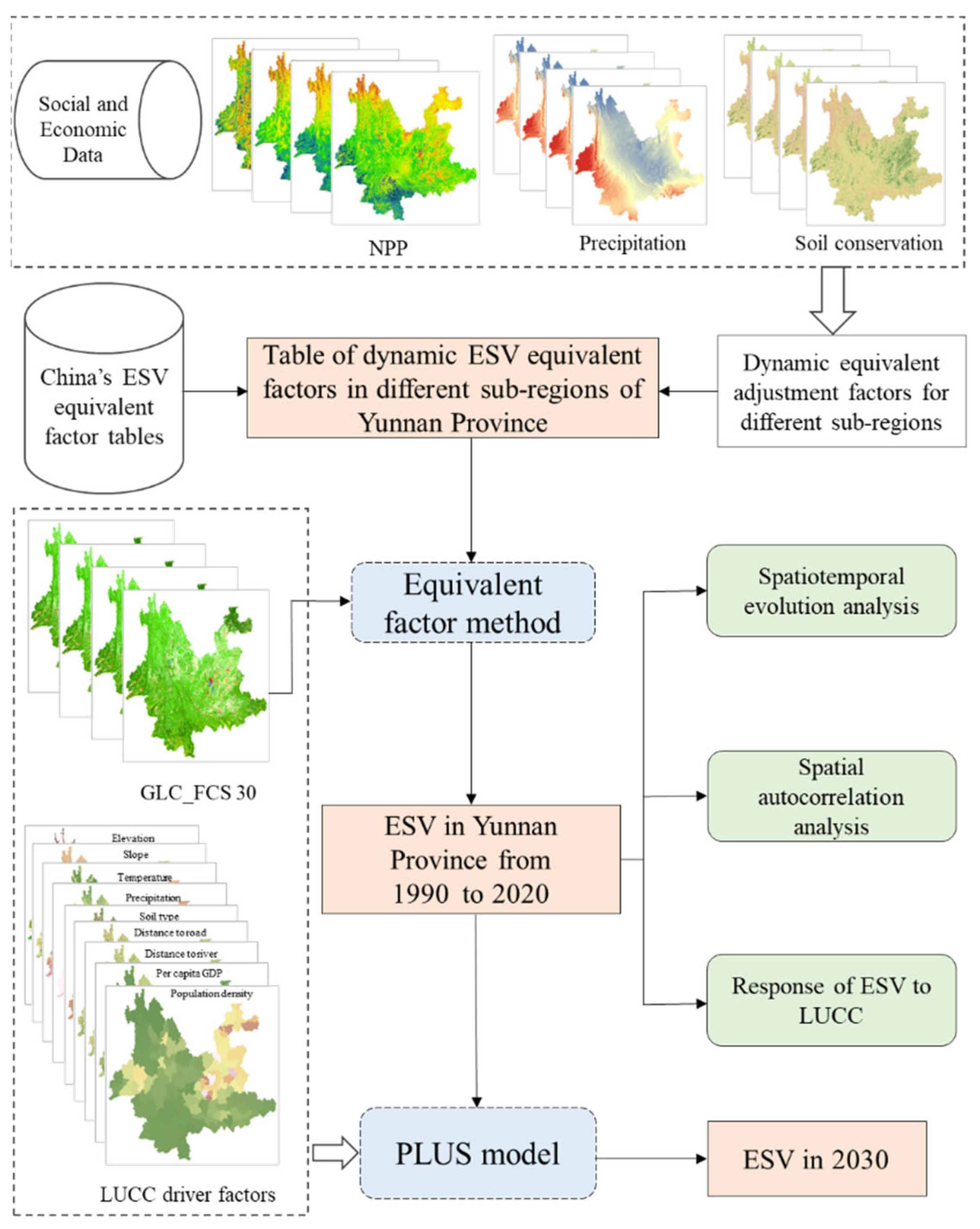



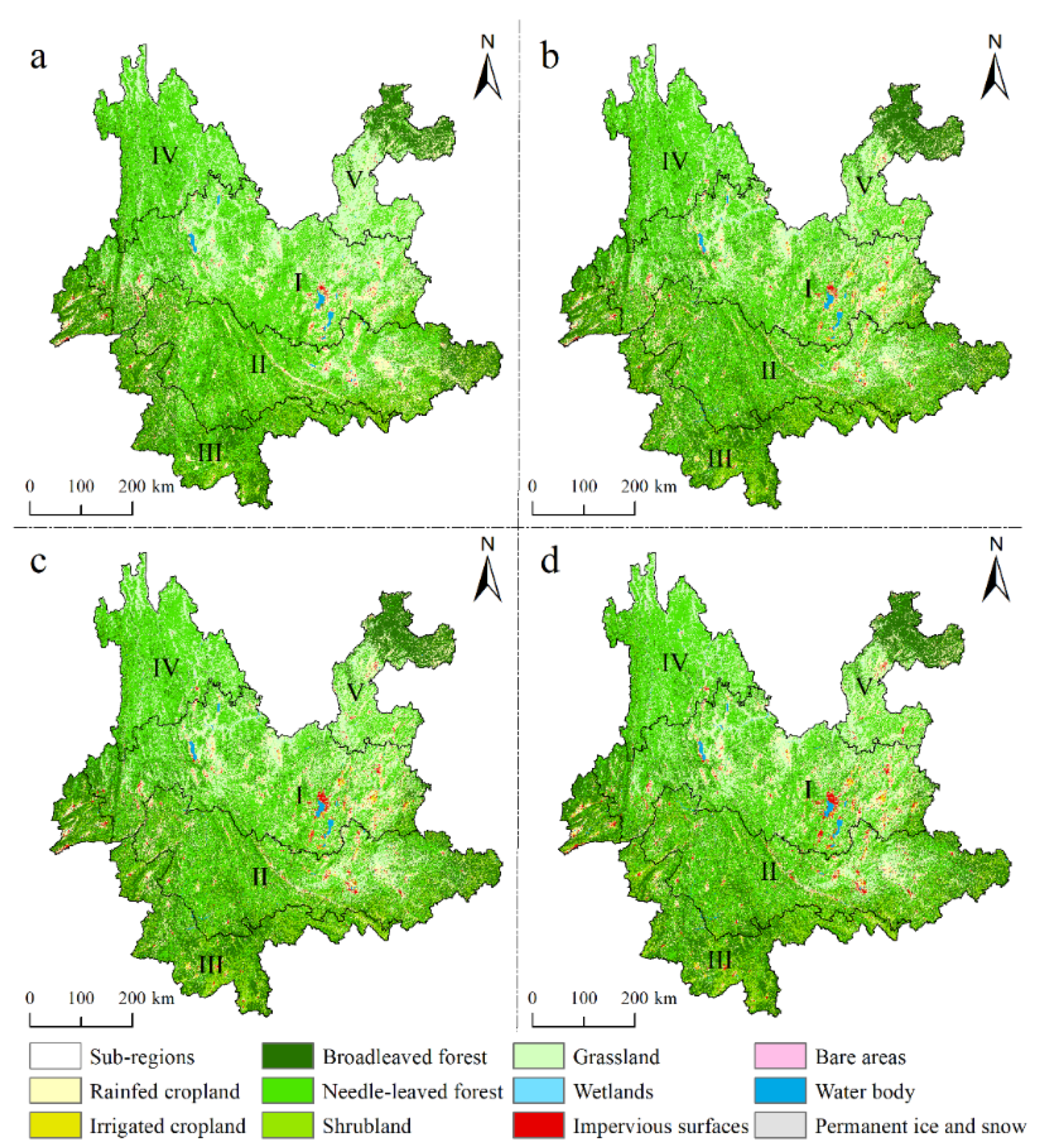
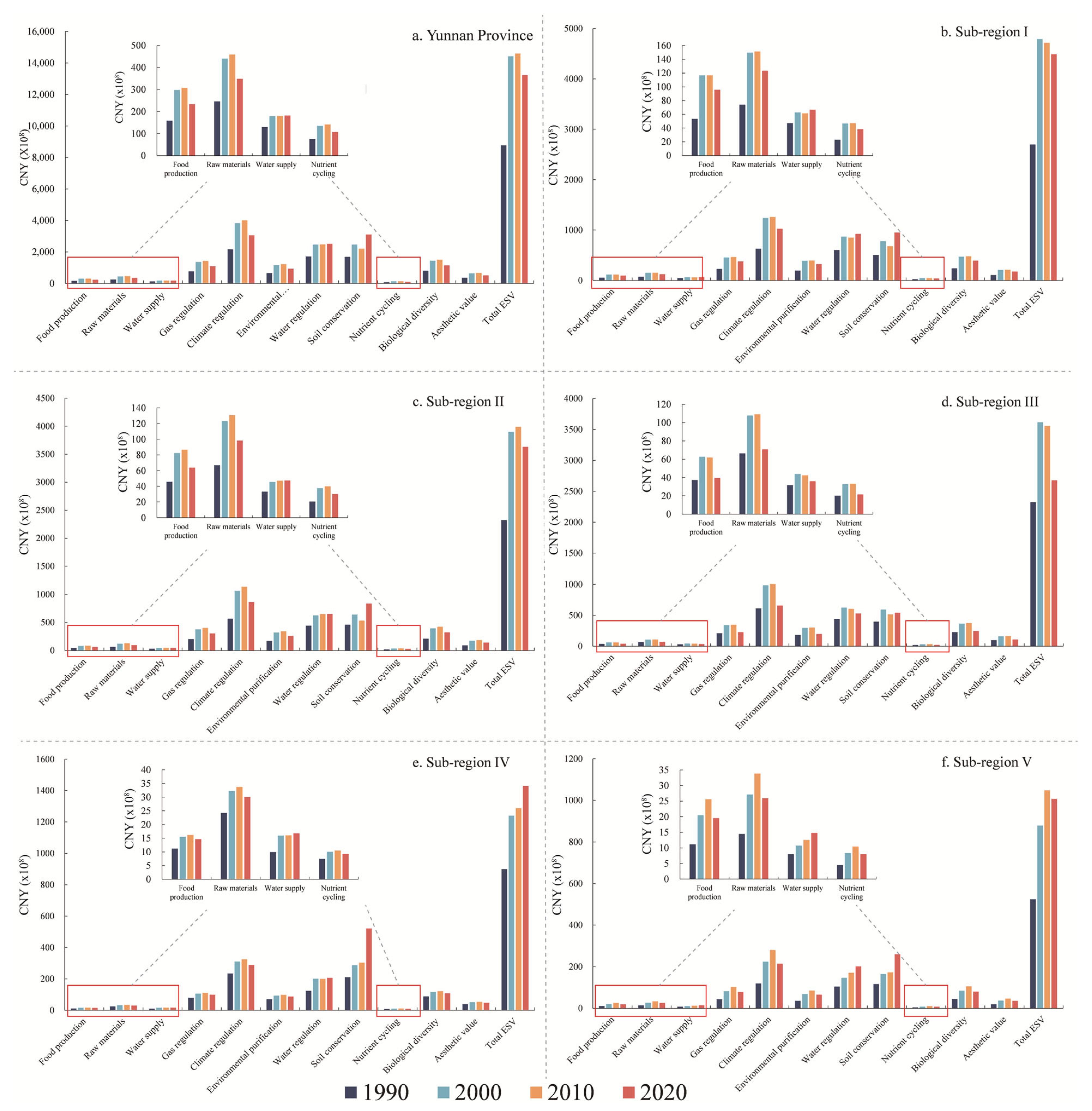
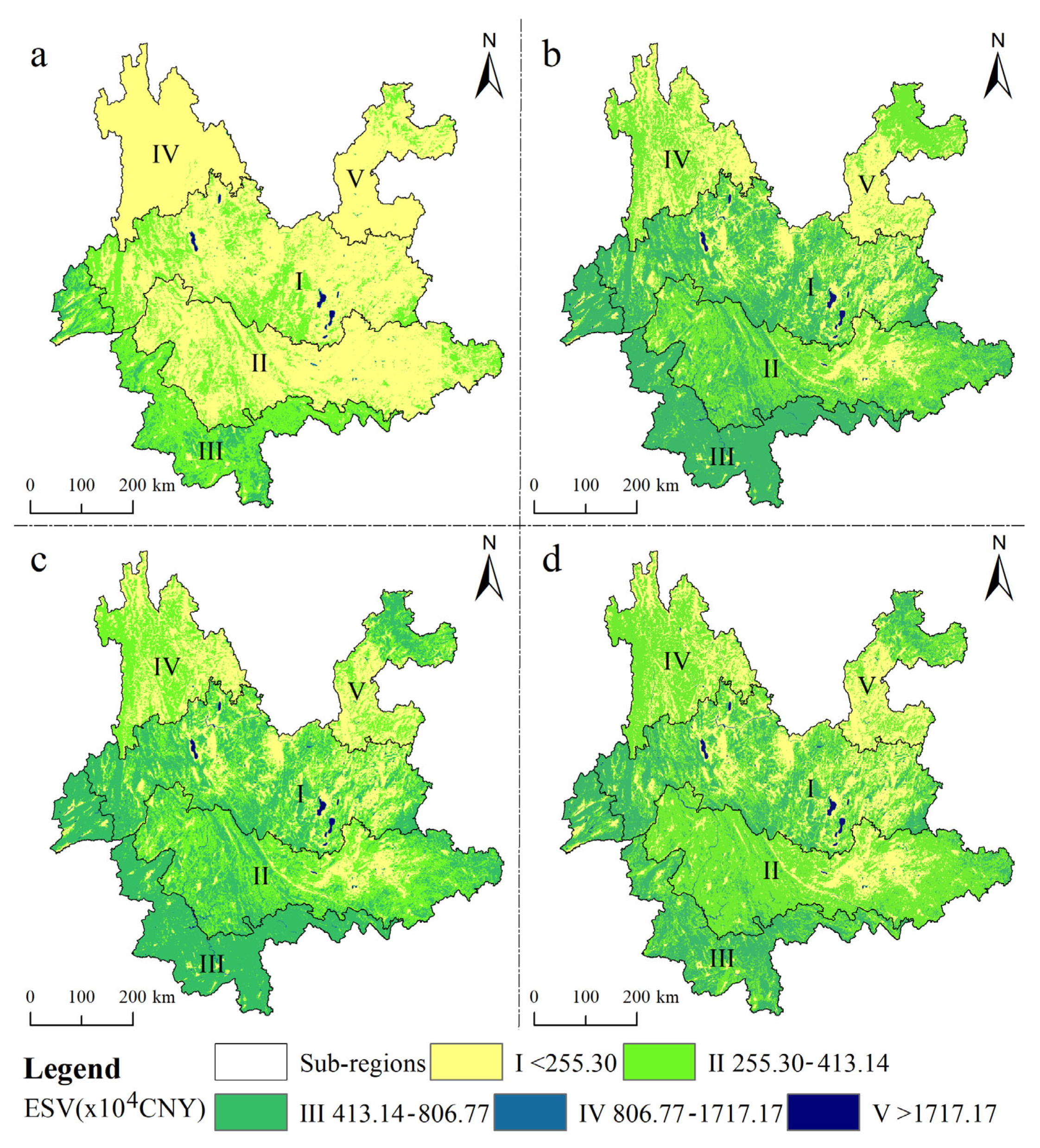

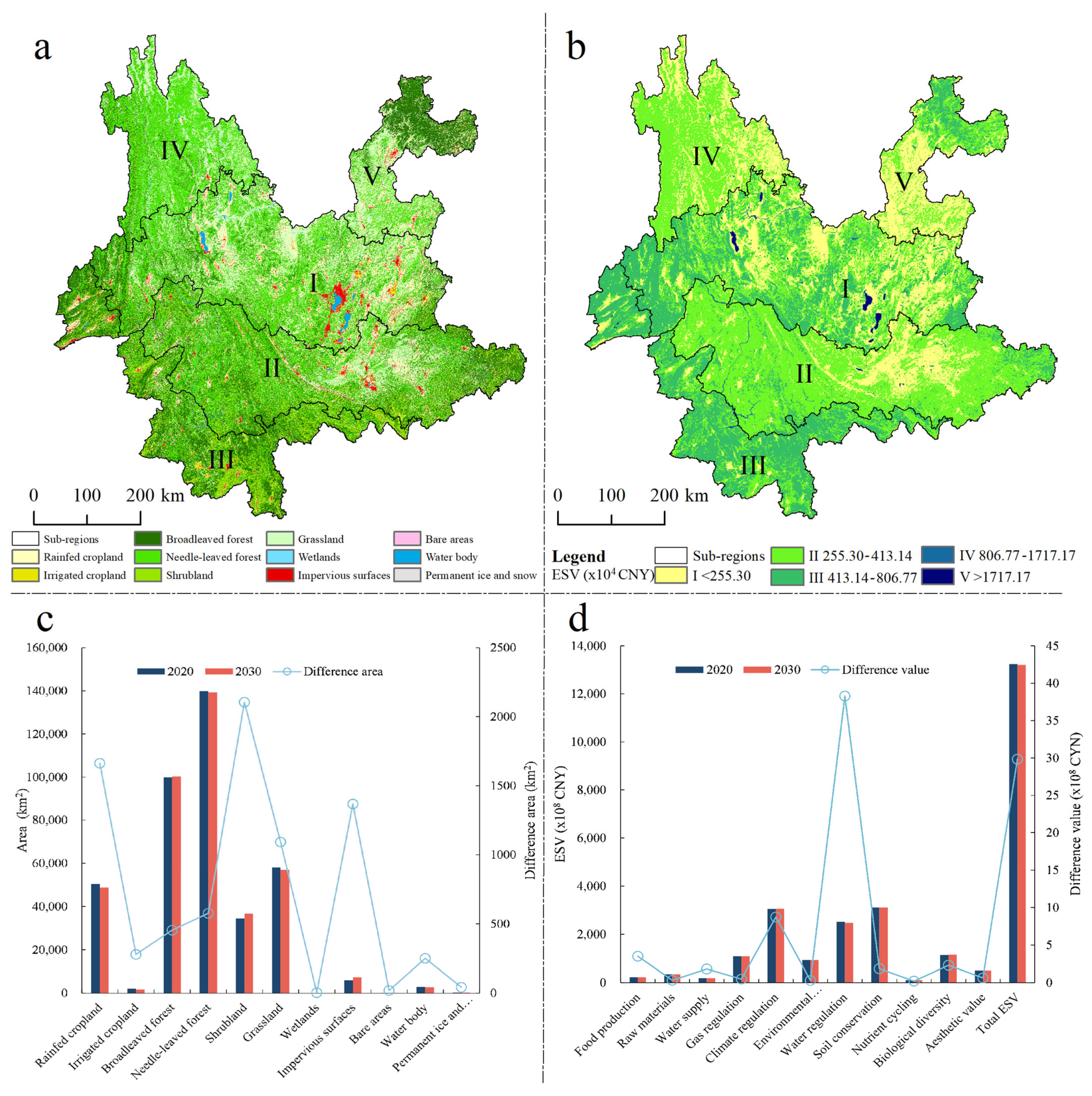

| Sub-Regions | 1990 | 2000 | 2010 | 2020 |
|---|---|---|---|---|
| I | 1497.11 | 1895.66 | 2060.33 | 2253.36 |
| II | 1033.83 | 1305.55 | 1440.97 | 1663.45 |
| III | 1235.26 | 1513.30 | 1589.53 | 1654.42 |
| IV | 857.28 | 1179.41 | 1314.86 | 1382.57 |
| V | 1212.10 | 1365.67 | 1711.71 | 1726.77 |
Disclaimer/Publisher’s Note: The statements, opinions and data contained in all publications are solely those of the individual author(s) and contributor(s) and not of MDPI and/or the editor(s). MDPI and/or the editor(s) disclaim responsibility for any injury to people or property resulting from any ideas, methods, instructions or products referred to in the content. |
© 2024 by the authors. Licensee MDPI, Basel, Switzerland. This article is an open access article distributed under the terms and conditions of the Creative Commons Attribution (CC BY) license (https://creativecommons.org/licenses/by/4.0/).
Share and Cite
He, S.; Wang, J.; Li, J.; Sha, J.; Zhou, J.; Jiao, Y. Quantification and Simulation of the Ecosystem Service Value of Karst Region in Southwest China. Land 2024, 13, 812. https://doi.org/10.3390/land13060812
He S, Wang J, Li J, Sha J, Zhou J, Jiao Y. Quantification and Simulation of the Ecosystem Service Value of Karst Region in Southwest China. Land. 2024; 13(6):812. https://doi.org/10.3390/land13060812
Chicago/Turabian StyleHe, Suling, Jinliang Wang, Jie Li, Jinming Sha, Jinchun Zhou, and Yuanmei Jiao. 2024. "Quantification and Simulation of the Ecosystem Service Value of Karst Region in Southwest China" Land 13, no. 6: 812. https://doi.org/10.3390/land13060812





